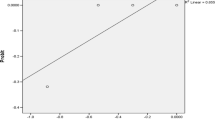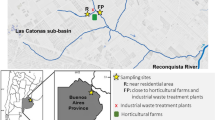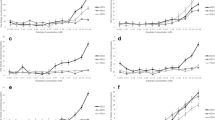Abstract
Organophosphates are known to inhibit the enzyme acetylcholinesterase. In this study, the AChE activity from the total soft tissues of Corbicula fluminea Mull. was used as a biomarker of organophosphate pollution in Pinacanauan River. Clams were collected from two different sites and at different seasons of the year. A colorimetric assay on the total soft tissues of the clams showed a directly proportional relationship between enzyme activity and condition of the riverine system. In vitro experiments on the total soft tissue, adductor muscles, digestive glands, and gills were conducted to assess the degree of localization of AChE as well as the sensitivity and tolerance of the enzymes in these tissues to varying concentrations of malathion. The degree of enzyme localization from highest to lowest is as follows: adductor muscle > gills > digestive gland whereas sensitivity to OP from greatest to least is: gills > adductor muscles > digestive gland.
Similar content being viewed by others
References
Adams, V. D. (1990). Water and wastewater examination manual. Michigan: Lewis.
Barnes, S., & Riggert, C. (2000). Tracking Missouri’s exotics. Missouri Conservationist, 61, 8–13.
Bedford, J. W., Reloffs, E. W., & Zabik, M. J. (1968). The freshwater mussel as a biological monitor of pesticide concentration in lotic environment. Limnology and Oceanography, 13, 118–136.
Bonacci, S., Browne, M. A., Dissanayake, A., Hagger, J. A., Corsi, I., Focardi, S., et al. (2004). Esterase activities in the bivalve mollusk Adamussium colbecki as a biomarker for pollution monitoring in the Antarctic marine environment. Marine Pollution Bulletin, 49, 445–455. doi:10.1016/j.marpolbul.2004.02.033.
Bradford, M. (1976). A rapid and sensitive method for the quantification of microgram quantities of protein utilizing the principle of protein–dye binding. Analytical Biochemistry, 72, 258–254. doi:10.1016/0003-2697(76)90527-3.
Brown, M., Davies, I. M., Moffat, C. F., Redshaw, J., & Craft, J. A. (2004). Characterization of choline esterases and their tissue and subcellular distribution in the mussel (Mytilus edulis). Marine Environmental Research, 57, 155–169. doi:10.1016/S0141-1136(03)00067-9.
Cairns, M. S., Maguire, C. C., Williams, B. A., & Bennett, J. K. (1991). Brain cholinesterase activity of bobwhite acutely exposed to chlorpyrifos. Environmental Toxicology and Chemistry, 10, 657–664. doi:10.1897/1552-8618(1991)10[657:BCAOBA]2.0.CO;2.
Cataldo, D. H., Boltovskoy, D., Stripeikis, J., & Pose, M. (2001). Condition index and growth rates of field caged Corbicula fluminea (Bivalvia) as biomarkers of pollution gradients in the Paraná River Delta, Argentina. Aquatic Ecosystem Health & Management, 4(2), 187–201. doi:10.1080/14634980127712.
Cooper, N. L., & Bidwell, J. (2006). Cholinesterase inhibition and impacts on behavior of the Asian clam, Corbicula fluminea, after exposure to an organophosphate insecticide. Aquatic Toxicology (Amsterdam, Netherlands), 76(3–4), 258–267. doi:10.1016/j.aquatox.2005.09.012.
Day, K. E., & Scott, I. M. (1990). Use of acetylcholinesterase activity to detect sublethal toxicity in stream invertebrates exposed to low concentrations of organophosphate insecticides. Aquatic Toxicology (Amsterdam, Netherlands), 8, 101–114. doi:10.1016/0166-445X(90)90021-G.
Dellali, M., Barelli, M. G., Romeo, M., & Aissa, P. (2001). The use of cholinesterase activity in Ruditapes decussates and Mytilus galloprovincialis in the biomonitoring of Bizerta lagoon. Comparative Biochemistry and Physiology, 130(Part C), 227–235. doi:10.1016/S1096-4959(01)00426-2.
Ellman, G. L., Courtney, K. O., Anders, V., Jr., & Featherstone, R. M. (1961). A new and rapid colorimetric determination of acetylcholinesterase activity. Biochemical Pharmacology, 7, 88–95. doi:10.1016/0006-2952(61)90145-9.
Escartin, E., & Porte, C. (1997). The use of cholinesterase and carboxylase activities from Mytilus galloprovincialis in pollution monitoring. Environmental Toxicology and Chemistry, 16, 2090–2095. doi:10.1897/1551-5028(1997)016<2090:TUOCAC>2.3.CO;2.
Eto, M. (1974). Organophosphorus pesticides: Organic and biological chemistry. Cleveland: CRC.
Galloway, T. S., & Depledge, M. H. (2001). Immunotoxicity in invertebrates: Measurement and ecotoxicological relevance. Ecotoxicology (London, England), 10, 5–23. doi:10.1023/A:1008939520263.
Galloway, T. S., Millward, N., Brown, M. A., & Depledge, M. H. (2002). Rapid assessment of organophosphorous/carbamate exposure in the bivalve mollusk Mytilus edulis using combined esterase activities as biomarkers. Aquatic Toxicology (Amsterdam, Netherlands), 61, 169–180. doi:10.1016/S0166-445X(02)00051-6.
Gupta, R. C., Patterson, G. T., & Dettbarn, W. D. (1985). Mechanisms involved in the development of tolerance to DFP toxicity. Fundamental and Applied Toxicology, 5, 517–528. doi:10.1016/0272-0590(85)90111-3.
Hartley, D. M., & Johnston, J. B. (1983). Use of the freshwater clam, Corbicila manilensis as a monitor for organochlorine pesticide. Bulletin of Environmental Contamination and Toxicology, 31, 33–40. doi:10.1007/BF01608763.
Hawkins, A. J. S., Smith, R. F. M., Tam, S. H., & Yasin, Z. B. (1998). Suspension-feeding behavior of tropical bivalve mollusk, Perna viridis, Crassostrea belcheri, Crassostrea iradelei, Saccostrea cuculata, Pinctada margariferia. Marine Ecology Progress Series, 66, 173–185. doi:10.3354/meps166173.
Jokanovic, M., Kosanovic, M., & Maksimovic, M. (1996). Interaction of the organophosphorous compounds with carboxylesterases in the rat. Archives of Toxicology, 70, 444–450. doi:10.1007/s002040050297.
Lau, P. S., & Wong, H. L. (2004). Effects of size, tissue parts and location on six biochemical markers in the green-lipped mussel, Perna viridis. Marine Pollution Bulletin, 46, 1563–1572. doi:10.1016/S0025-326X(03)00321-7.
Lehtonen, K. K., & Leinio, S. (2003). Effects of exposure to copper and malathion on metallothionien levels and acetylcholinesterase activity of the mussel Mytilus edulis and the clam Macoma baltica from the Northern Baltic Sea. Bulletin of Environmental Contamination and Toxicology, 79, 489–496. doi:10.1007/s00128-003-8853-6.
Liao, C. M., Jou, L. J., & Chen, B. C. (2005). Risk-based approach to appraise valve closure in the clam Corbicula fluminea in response to waterborne metals. Environmental Pollution, 135(1), 41–52. doi:10.1016/j.envpol.2004.10.015.
Maxwell, D. M. (1992). Detoxification of organophosphorous compounds by carboxylesterase. In J. E. Chambers & P. E. Levi (Eds.), Organophosphates chemistry fate and effects. San Diego: Academic.
McHenery, J. G., Lindley-Adams, G. E., Moore, D. C., Rodger, G. K., & Davies, I. M. (1997). Experimental and field studies of effects of dichlorvos exposure on acetylcholinesterase activity in the gills of the mussel, Mytilus edulis L. Aquatic Toxicology (Amsterdam, Netherlands), 38, 125–143. doi:10.1016/S0166-445X(96)00834-X.
McMahon, R. F. (2001). Mollusca: Bivalvia. In J. H. Thorp & A. P. Covich (Eds.), Ecology and classification of North American freshwater invertebrates (2nd ed., pp. 331–430, pp. 1056). San Diego: Academic.
McMahon, R. F., & Williams, C. J. (1986). Growth, life cycle, upper thermal limit and downstream colonization rates in a natural population of the freshwater bivalve molluscs, Corbicula fluminea (Muller) receiving thermal effluents. American Malacological Bulletin, Special Ed. No. 2, 231–239.
Mora, P., Fournier, D., & Narbonne, J. F. (1999). Cholinesterases from the marine mussels Mytilus galloprovincialis Lmk. and Mytilus edulis L. and from the freshwater bivalve Corbicula fluminea Mull. Comparative Biochemistry and Physiology, 122(3), 353–361.
Muncaster, B. W., Hebert, P. D. N., & Lazar, R. (1990). Biological and physiological factors affecting the body burden of organic contaminants in freshwater mussels. Archives of Environmental Contamination and Toxicology, 19, 25–34. doi:10.1007/BF01059809.
NPAL Philippines (1990). In house method on determination of organophosphate pesticides in water by gas chromatography with a nitrogen–phosphorus detector. Manila: National Pesticide Analytical Laboratory, Bureau of Plant Industry, Department of Agriculture.
Owen, R., Buxton, L., Sarkis, S., Toaspern, N., Knap, A., & Depledge, M. (2002). An evaluation of hemolymph cholinesterase activities in the tropical scallop, Euvola ziczac, for the rapid assessment of pesticide exposure. Marine Pollution Bulletin, 44, 110–117.
Parkinson, A. (1996). Biotransformation of xenobiotics. In C. D. Klaasen (Ed.), Casarett and Doull’s toxicology. The basic science of poisons (5th ed., pp. 230–278). New York: McGraw Hill.
Pereira, W. E., Domagalski, J. L., & Hostettler, F. D. (1996). Occurrence and accumulation of pesticides and organic contaminants in river sediments, water and clam tissues from the San Joaquin River and tributaries, California. Environmental Toxicology and Chemistry, 5, 172–180. doi:10.1897/1551-5028(1996)015<0172:OAAOPA>2.3.CO;2.
Pfeifer, S., Schiedek, D., & Dippner, J. W. (2005). Effect of temperature and salinity on AChE activity, a common pollution biomarker in Mytilus sp. from South Western Baltic Sea. Journal of Experimental Marine Biology and Ecology, 320, 93–103. doi:10.1016/j.jembe.2004.12.020.
Simon, O., & Laplace, J. G. (2004). Kinetic analysis of uranium accumulation in the bivalve Corbicula fluminea: Effect of pH and direct exposure levels. Aquatic Toxicology (Amsterdam, Netherlands), 68(2), 95–108. doi:10.1016/j.aquatox.2004.03.002.
Smith, V. J. (1991). Invertebrate immunology, phylogenetic, ecotoxicological and biomedical implications. Comparative Haematology International, 1, 61–76. doi:10.1007/BF00422876.
Soucek, D. J., Schimdt, T. S., & Cherry, D. S. (2001). In situ studies with the Asian clams, Corbicula fluminea to detect acid mine drainage and nutrient inputs in low order streams. Canadian Journal of Fisheries and Aquatic Sciences, 58, 602–608. doi:10.1139/cjfas-58-3-602.
Varela, V. W., & Ausperger, T. (1996). Cholinesterase activity as a device for biomonitoring pesticide exposure in the freshwater mussel, Elliptio complanata (pp. 110–115). Raleigh: US Fish and Wildlife Service.
Author information
Authors and Affiliations
Corresponding author
Rights and permissions
About this article
Cite this article
Beltran, K.S., Pocsidio, G.N. Acetylcholinesterase activity in Corbicula fluminea Mull., as a biomarker of organophosphate pesticide pollution in Pinacanauan River, Philippines. Environ Monit Assess 165, 331–340 (2010). https://doi.org/10.1007/s10661-009-0949-y
Received:
Accepted:
Published:
Issue Date:
DOI: https://doi.org/10.1007/s10661-009-0949-y




